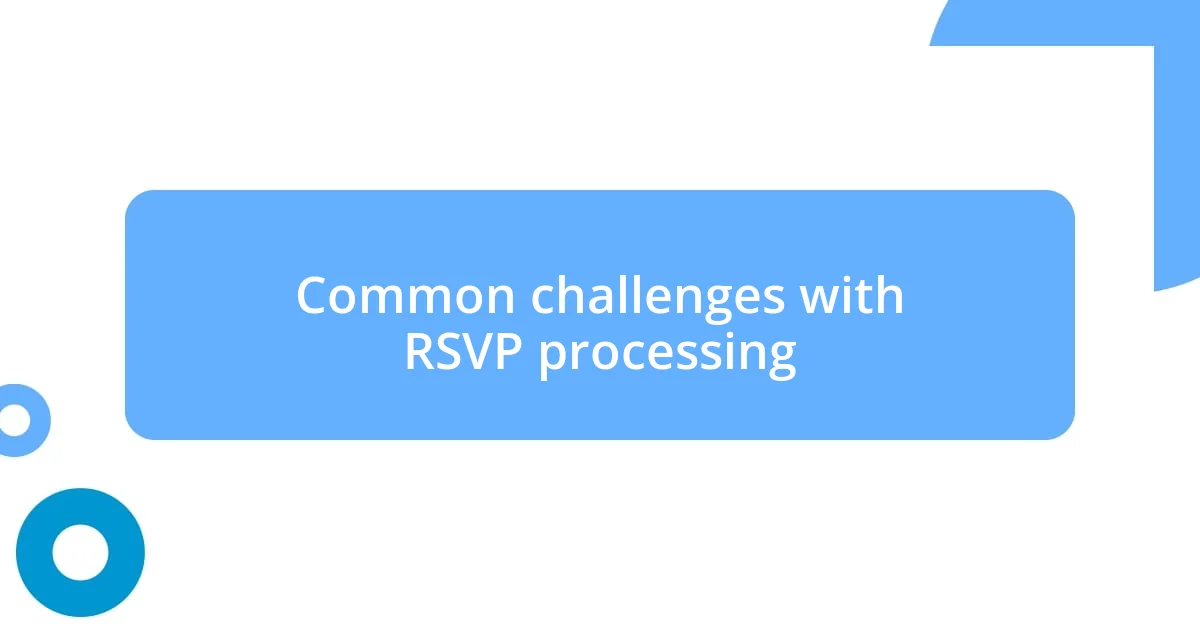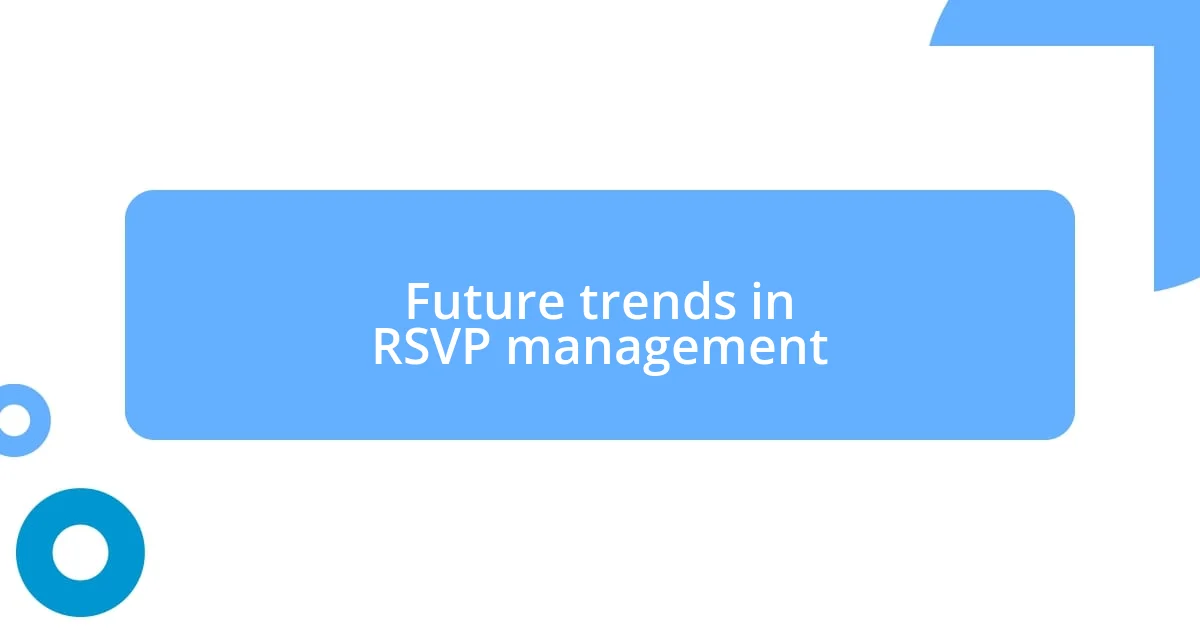Key takeaways:
- RSVPs are essential for event planning, providing clarity and emotional validation for hosts and guests alike.
- Common challenges in RSVP processing include inconsistent responses, miscommunication, and timing issues, which can create significant planning stress.
- Utilizing digital tools can streamline RSVP management, enhance guest engagement, and foster a more enjoyable planning experience.

Understanding RSVP significance
When I think about the significance of RSVPs, it’s easy to overlook their importance. They aren’t just formality; they’re crucial for planning. I remember a time when I hosted a small dinner party, and the lack of clear responses left me scrambling to find chairs and prepare enough food, wondering who would actually show up.
The emotional weight of an RSVP can’t be understated. It’s an acknowledgment of connection—an affirmation that your invitation matters. I once sent out invitations to a milestone celebration, and when guests replied, I felt genuinely valued and excited, knowing they cared enough to confirm their presence.
But have you ever considered how RSVPs impact logistics? I found it striking how many event hosts struggle with seating arrangements and catering without accurate headcounts. A simple response can transform chaos into clarity, making the difference between a seamless event and a stressful one. Isn’t that worth considering?

Common challenges with RSVP processing
When it comes to processing RSVPs, one significant challenge I’ve encountered is the inconsistency in responses. Some guests might respond promptly, while others seem to take their time—or never respond at all. I once hosted a wedding where the RSVP system fell apart; we had 50 yeses and 20 maybes, and I couldn’t finalize crucial details like dinner selections. The uncertainty can lead to a lot of frustration for the host.
Another common issue is miscommunication regarding the RSVP instructions. Despite my efforts to clarify how to respond, guests still interpreted the details differently. I remember an event where several attendees showed up without a confirmation, thinking they’d just “wing it.” That experience taught me how a lack of clarity can lead to overcrowding or empty seats, which ultimately detracts from the experience for everyone involved.
Additionally, timing is often a considerable hurdle. I often find that responses trickle in close to the deadline, leaving little room for adjustments. For example, during one particular birthday celebration, the last-minute confirmations forced me to scramble for additional seating and food. It felt like a race against time to make sure everything was perfect, highlighting how crucial early responses can be in planning an organized event.
| Challenge | Description |
|---|---|
| Inconsistent Responses | Guests respond at different rates, complicating planning. |
| Miscommunication | Guests interpret RSVP instructions differently, leading to unexpected attendees. |
| Timing Issues | Last-minute confirmations create stress and limit planning flexibility. |

Tools for effective RSVP management
When it comes to managing RSVPs effectively, I’ve found that utilizing the right tools can make all the difference. Digital platforms have transformed this task from a chaotic mess into a streamlined process. For instance, I once used a dedicated RSVP management tool for my sister’s wedding, which not only allowed guests to respond online but also sent automated reminders. This simple change drastically reduced the time I spent tracking down answers, and I felt a wave of relief as confirmations rolled in.
Here are some tools that can enhance RSVP management:
- Eventbrite: A comprehensive platform that handles invitation sending and responses while providing analytics on guest engagement.
- Google Forms: A customizable, free option that allows for tailored questions and easy data compilation.
- Paperless Post: Offers beautiful electronic invitations that come with built-in RSVP tracking, making it visually appealing and functional.
- Evite: Known for its user-friendly interface, this tool also serves up engaging designs and RSVP reminders for guests.
- Facebook Events: While casual, it can create buzz and quickly compile responses in a familiar environment.
Using these tools not only simplifies the process, but it also allows for a more enjoyable experience overall. I remember how it felt to see organized lists of attendees—my stress melted away, and I could finally focus on the fun parts of event planning, like decorations and themes, rather than worrying about who might show up.

Step-by-step RSVP streamlining process
Streamlining the RSVP process requires a clear plan. First, I set a firm deadline. I once had an event where I didn’t establish a cutoff, and I ended up with a flurry of last-minute responses that nearly derailed everything. By giving guests a specific date, I was able to create a sense of urgency and ensure I had all necessary details in hand with ample time to prepare.
Next, I provide simple and concise instructions for responding. Emphasizing clarity was crucial for an outdoor party I organized last summer. I included a brief video tutorial on my invitation, which reduced confusion. Afterward, I reflected on how this little extra effort fostered positive interactions and kept stress levels low. Isn’t it amazing how a few extra steps can create such a smoother experience?
Lastly, I make it a habit to engage with the guests who haven’t responded as the deadline approaches. A friendly text or email can encourage those who might just need a nudge. For instance, I reached out to a few friends before my last gathering, and it not only resulted in a warmer response but also sparked excitement about the event. Isn’t it nice when a simple check-in can transform uncertainty into enthusiasm?

Evaluating RSVP response outcomes
Evaluating the outcomes of RSVP responses can be eye-opening. After implementing a streamlined process for my annual holiday party, I took time to review the response rates. Surprisingly, I found that clear communication and timely follow-ups not only improved guest engagement but also made me feel more in control—like stepping onto solid ground after a period of uncertainty. It’s incredible how the right approach transforms what once felt overwhelming into manageable data.
In one event, I used a digital tool that allowed me to visualize response patterns. I could see at a glance who was attending, who was undecided, and who hadn’t responded at all. This clarity was refreshing! I remember sighing in relief as I ticked off names, knowing exactly who to nudge without fear of stepping on toes. Have you ever experienced that moment of clarity where everything suddenly makes sense? It’s like discovering the missing piece of a puzzle.
Analyzing RSVP outcomes also revealed valuable trends. For instance, I noticed that guests who received reminders via text were much more likely to respond—an unexpected, yet insightful detail. This prompted me to integrate these reminders into my future strategies. It’s amazing how a simple tweak, like switching from an email to a text, can enhance engagement! Does understanding these patterns not make you curious about what simple adjustments could elevate your own events? Embracing these insights shaped not only my planning but also the overall experience for my guests.

Future trends in RSVP management
Managing RSVPs has evolved rapidly, and I see a future where technology plays an even bigger role. Online platforms are becoming more intuitive, allowing hosts to customize their responses seamlessly. For example, I recently discovered an app that not only tracks who’s coming but also lets guests chat with each other, making the anticipation of the event even more exciting. Isn’t it fascinating how technology can transform a simple RSVP into a social experience?
As I think about the future, I can’t help but notice the growing trend of personalized communication. Consider how much more meaningful it is to receive a tailored message asking whether you’ll attend, rather than a generic invite. I once sent a quick video invitation to close friends instead of a standard email. The laughter it brought while watching my awkward yet heartfelt attempt at humor was unforgettable! It’s these little personalized touches that, in my opinion, will foster stronger connections and deepen friendships in future gatherings. Wouldn’t you agree that a personal touch often makes the biggest difference?
Furthermore, I believe there’s a rising expectation for environmental responsibility when it comes to RSVPs. More people seem to be looking for eco-friendly alternatives, like digital invites instead of paper ones. I remember feeling proud when I switched to electronic invites for my last garden party, knowing I was reducing waste while still being stylish. And let’s be honest, wasn’t it a relief to skip the stamps? This shift not only aligns with our values but also opens up discussions about sustainability with our guests. Wouldn’t it be wonderful if every RSVP process could reflect our commitment to the planet?














